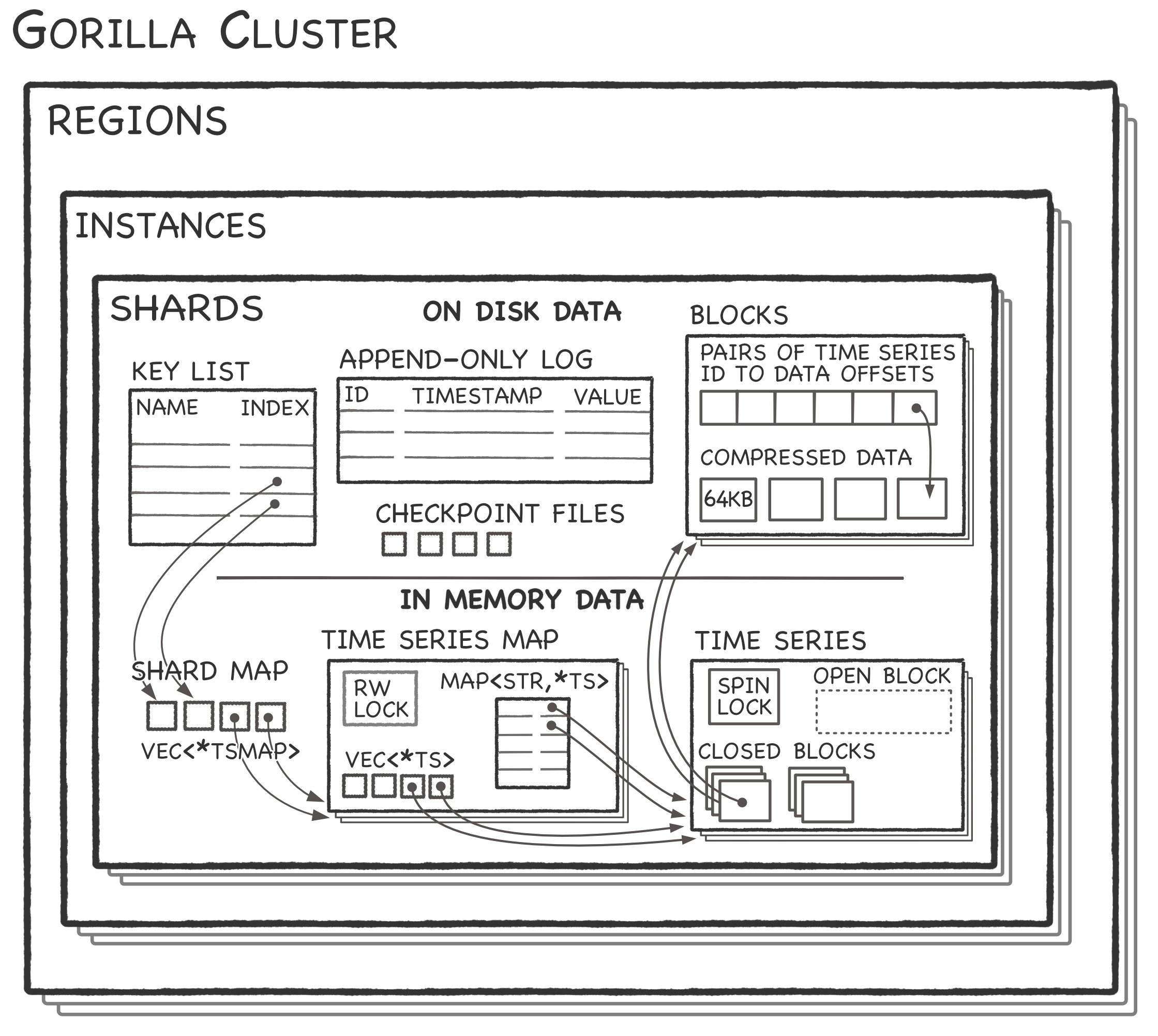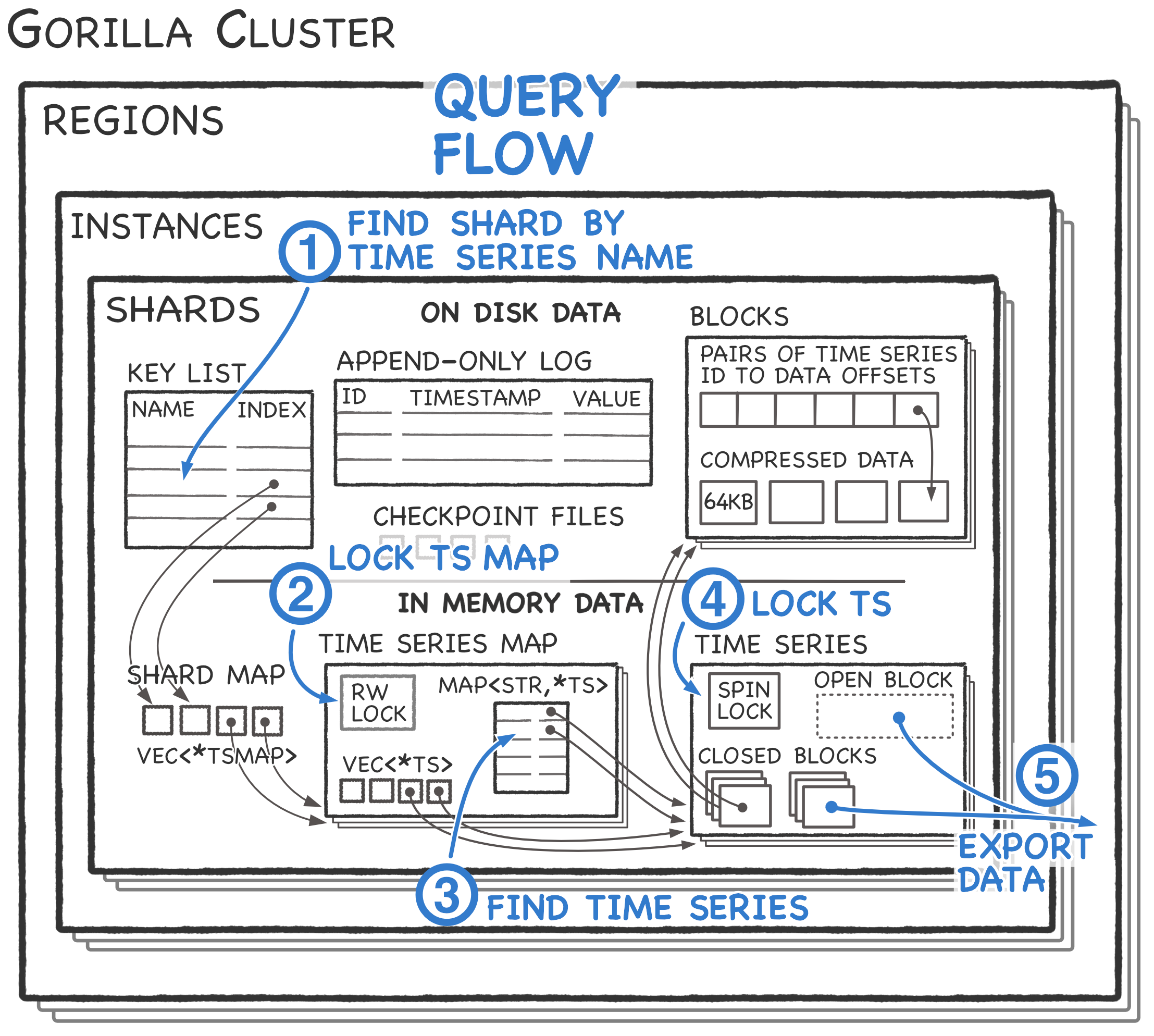Gorilla Time Series Database
Gorilla is an in-memory, time series database from Facebook optimized for writes, reading data in a few milliseconds, and high availability. Facebook open-sourced the code as Beringei, but the maintainers archived the repo. At its core, Gorilla is a 26-hour write-through cache backed by durable storage in HBase, a distributed key-value store. Gorilla’s contributions include a novel, streaming timestamp compression scheme.
Paper: Gorilla: A Fast, Scalable, In-Memory Time Series Database

Gorilla optimizes for four attributes:
-
High data insertion rate. The primary requirement is that Gorilla should always be available to take writes. The expected insertion rate is 10M data points per second. Each data point consists of a 64 bit timestamp with a 64 bit float value.
-
Real-time monitoring to show new data within tens of seconds.
-
Read latency in less than millisecond and fast scans over all in-memory data in tens of milliseconds.
-
Reliability requirements. Gorilla always serves reads even if a server crashes or when an entire region fails.
Gorilla compromises on the following attributes:
- Flexibility. The only supported data type is a named stream of 64 bit floating point values. Higher level abstractions can be built on top of Gorilla.
- Duration. Gorilla only stores the last 26 hours of data.
- Granularity. The minimum granularity is 15 seconds.
- Durability. A server crash can cause data loss of up to 64kB which is 1-2 seconds of data. During prolonged outages, Gorilla preserves the most recent 1 minute of data and discards the rest of the data.
- Consistency. Data is streamed between datacenter regions without attempting to guarantee consistency.
- Query flexibility. Gorilla serves raw compressed blocks to clients. There’s no query engine in Gorilla so clients are expected to process the compressed blocks.
Time stamp compression¶
Gorilla introduces a novel lossless compression scheme for streaming timestamps. Gorilla’s timestamp encoding is based on the observation that the vast majority of timestamps arrive at a fixed interval. A fixed interval is common if metrics are pulled from servers at regular intervals, like every 30 seconds. Using sampled production data, the Gorilla team found 96% of timestamps compress to a single bit with the compression scheme.
To implement the compression, each stream is divided into blocks aligned at
two-hour intervals. The block header contains a 64 bit timestamp of the
beginning of the block, e.g. 2019-09-05T02:00. The first timestamp is the
delta from the header timestamp stored in 14 bits. Using 14 bits allows one
second granularity within the two hour window. Subsequent timestamps are encoded
with a double delta scheme as shown below:
# Block timestamp aligned to 8:00:00. timestamps = [8:00:30, 8:01:30, 8:02:30, 8:03:28] deltas = [ 30, 60, 60, 57] double_deltas = [ , 30, 0, -3]
The double_deltas are encoded using a variable sized integer encoding similar
to the varint encoding in Protocol Buffers described below:
The delta_deltas are encoded using a variable sized integer encoding.
- If the delta is zero, store a single
0bit. - If the delta is in
[-64, 64)store0b10followed by the signed value in 7 bits. - If the delta is in
[-256, 256)store0b110followed by the signed value in 9 bits. - If the delta is in
[-2048, 2048)store0b1110followed by the signed value in 12 bits. - Otherwise, store
0b1111followed by the delta in 32 bits.
The 4 timestamps would be encoded as follows:
Block header: Timestamp at 08:00:00 in 64 bits. # Encode the first value as a delta from the block header (not double delta) # Use 14 bits to allow 1 second precision in a 2 hour block. binary(30) in 14 bits # Encode the second value using the double delta varint scheme above. The double # delta is in the range [-64, 64), so use 0b10 followed by 7 bits of the # signed value. 0b10 + binary(30) in 7 bits # Encode the third value using the double delta scheme. The value is 0, # so use a single 0 bit. 0 # Encode the fourth value using the double delta scheme. The double delta, -3, # is in the range [-64, 64). 0b10 + binary(-3)
Time series value compression¶
Gorilla uses xor compression for the floating point values associated with a
timestamp. Using xor on similar float values drops the sign, exponent, and first
few bits of the mantissa from the floating point value. This compression scheme
takes advantage of the fact that most values don’t change significantly compared
to neighboring values. The Gorilla team found that 59% of values are identical
to the previous value and compress to a single 0 bit. Since the encoding is
variable length, the entire two hour block must be decoded to access values.
This isn’t a problem for time series databases because the value of the data
lies in aggregation, not in single points.
Architecture¶

Gorilla runs instances in two redundant regions. Both regions consist of many instances. Each instance contains a number of shards. Each shard contains many named time series. Time series data in blocks and in the append-only log is persisted on a distributed file system for durability. Gorilla instances replicate shard data to the corresponding shard in the other region but make no attempt to maintain consistency between shards in each region.
A Paxos-based system called ShardManager assigns shards to nodes. I think each time series is contained by a single shard. It’s unclear if Gorilla mitigates hotspots that might occur for frequent metrics. The in-memory organization of Gorilla is a two-level map:
- The time series map is the first level map from a shard index to a time series map. The key list contains the mapping between a time series name and its shard index.
- The time series map maps a string name to a
TimeSeriesdata structure. Additionally, time series map maintains a vector of the sameTimeSeriesdata structures for efficient scans over the entire dataset. - The
TimeSeriesdata structures consists of an open block for incoming writes and two-hour closed blocks for the previous 26 hours.
Query flow¶

The TimeSeries data structure is a collection of closed blocks containing
historical data and a single open block containing the previous two hours of
data. Upon receiving a query:
- The Gorilla node checks the key list to get the index of the shard containing the named time series. Gorilla uses the index in the shard map to get the pointer to time series map.
- Gorilla read locks the time series map to prevent race conditions.
- Using the map, Gorilla looks up and copies the pointer to the time series and then releases the read lock.
- Gorilla spin locks the time series to avoid mutation while data is copied. Finally, Gorilla copies the data as it exists to the outgoing RPC. Notably, Gorilla sends the compressed form of data to clients. Gorilla expects clients to decompress the compressed data.
Write flow¶

- First, Gorilla looks up the shard ID to get the directory containing the append-only log for the data.
- Gorilla appends the data to a shard-specific log. The log is not a write
ahead log. Gorilla only writes data once it has 64kb of data for the shard
which is 1-2 seconds of data. The log must include a 32bit integer ID to
identify the named timestamp which increases the data size dramatically
compared to the compression scheme within a
TimeSeriesdata structure. - Similarly to the query flow, Gorilla uses the shard map and time series map to find the correct time series data structure. Gorilla appends the data to the open block in the time series data structure using the compression algorithm described above.
- After two hours, the Gorilla node closes all open blocks and flushes each one
to disk with a corresponding checkpoint file. After all
TimeSeriesdata structures for a shard are flushed, the Gorilla node deletes the append-only log for that shard.